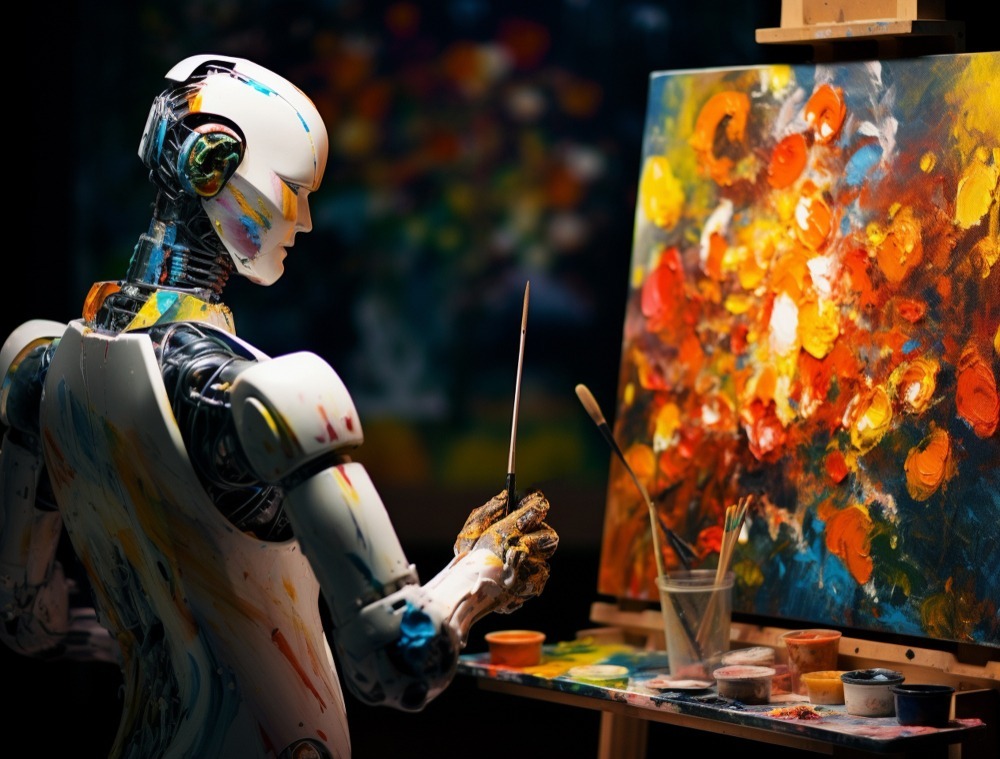The world of art is undergoing a seismic shift. Artificial intelligence (AI) is rapidly transforming the way art is created, experienced, and understood. From generating original works to curating personalized exhibitions, AI is pushing the boundaries of artistic expression and challenging traditional notions of creativity.
The Rise of AI Art
One of the most significant impacts of AI is the emergence of AI-generated art. Algorithms trained on vast datasets of existing art can create original works in various styles and mediums. This includes:
- Visual Art: AI can generate realistic images, abstract paintings, and even sculptures, often blurring the lines between human and machine creation.
- Music: AI algorithms can compose original music pieces in various genres, mimicking the styles of famous composers or exploring entirely new sonic landscapes.
- Literature: AI can write poetry, scripts, and even novels, offering unique perspectives and creative possibilities.
The Impact of AI on the Art World
AI is not just about creating new art forms; it is also transforming the way art is experienced and interacted with. Here are some key areas of impact:
- Personalized Art Experiences: AI can analyze individual preferences and recommend artwork that resonates with them. This can lead to more engaging and immersive art experiences.
- Art Accessibility: AI tools can make art more accessible to people with disabilities, such as creating audio descriptions of visual art or translating sign language into dance performances.
- Democratization of Art Creation: AI-powered tools are making art creation more accessible to everyone, regardless of artistic background or skill level. This can empower individuals to explore their creativity and express themselves in new ways.
- Art Curation and Preservation: AI can assist in curating exhibitions, identifying patterns and connections within vast collections of art. It can also help in the preservation of cultural heritage by analyzing and restoring historical artworks.
The Future of Art with AI
While AI is revolutionizing the art world, it also raises important questions about the role of technology in creativity, the definition of art itself, and the ethical considerations surrounding AI-generated works.
However, the potential of AI in art is undeniable. As AI technology continues to evolve, we can expect to see even more innovative and groundbreaking applications in the future. Here are some exciting possibilities:
- Collaborative Art Creation: AI can become a powerful tool for collaboration between human artists and machines, leading to the creation of truly unique and hybrid art forms.
- Interactive and Immersive Art Experiences: AI can be used to create interactive and immersive art experiences that respond to the audience’s presence and emotions.
- New Forms of Artistic Expression: AI can help us explore entirely new forms of artistic expression that were previously unimaginable, pushing the boundaries of creativity and human-machine collaboration.
The Rise of the Metaverse: A New Frontier for Social Interaction
The internet has revolutionized how we connect and interact. From email to social media, we’ve witnessed a continuous evolution in the way we share information, build communities, and engage with the world around us. Now, the metaverse is poised to take this interaction to a whole new level, offering a virtual space for immersive experiences and social connection.
What is the Metaverse?
The metaverse is a term used to describe a network of interconnected virtual worlds where users can interact with each other and digital objects in a real-time, 3D environment. It’s not just a game or a platform; it’s envisioned as a persistent, shared space that can be accessed through various devices, including VR headsets, AR glasses, and even smartphones.
How will the Metaverse Change Social Interaction?
The metaverse has the potential to fundamentally change the way we socialize and connect with others. Here are some key ways it might impact our social lives:
- Immersive Experiences: Imagine attending a virtual concert with friends from across the globe, or collaborating on a project in a shared virtual workspace. The metaverse allows for a level of immersion and presence that traditional online interactions simply cannot match.
- Enhanced Communication: Beyond text and video chat, the metaverse opens the door for more expressive and nuanced communication. Avatars can convey emotions through body language and facial expressions, creating a more natural and engaging social experience.
- Building Communities: The metaverse can foster a sense of community by providing dedicated spaces for people with shared interests to gather, interact, and collaborate. This could lead to the formation of new online communities and the strengthening of existing ones.
- Accessibility and Inclusivity: The metaverse has the potential to make social interaction more accessible and inclusive for people with disabilities. Virtual avatars can remove physical limitations, allowing everyone to participate in social activities on an equal footing.
Challenges and Considerations
While the metaverse holds immense potential for social interaction, there are also challenges to consider:
- Privacy and Security: Protecting user data and ensuring online safety will be crucial in the metaverse. Robust security measures and clear privacy policies will be essential to building trust and encouraging widespread adoption.
- Digital Divide: Access to the necessary hardware and technology could exacerbate the digital divide, leaving some individuals and communities behind. Ensuring affordability and accessibility will be key to making the metaverse truly inclusive.
- The Impact on Mental Health: The immersive nature of the metaverse could lead to concerns about addiction and the blurring of lines between the virtual and real worlds. It’s important to be mindful of these potential issues and promote responsible use.
Conclusion
Both artificial intelligence and the metaverse represent significant advancements in technology that hold the potential to reshape our world in profound ways. AI is pushing the boundaries of artistic expression, while the metaverse is creating a new frontier for social interaction.As these technologies continue to evolve and integrate, we can expect to see even more exciting developments. AI-powered tools could be used to create personalized and immersive art experiences within the metaverse, further blurring the lines between reality and the virtual world.However, it’s crucial to approach these advancements with a critical eye. We must consider the potential ethical implications, address concerns about accessibility and inclusivity, and ensure responsible development and use.Ultimately, the future of art and social interaction lies in the hands of both creators and users. By embracing the possibilities of AI and the metaverse while remaining mindful of the challenges, we can work together to build a more creative, connected, and inclusive future for everyone.


